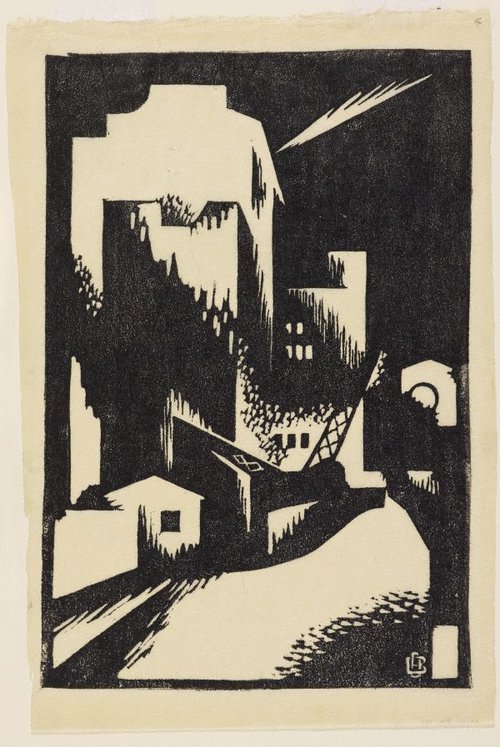Title
Mirmande (with surrounding hills)
1934
Artist
-
Details
- Other Titles
- Mirmande
Mirmanda - Place where the work was made
-
Salisbury
→
England
- Date
- 1934
- Media category
- Painting
- Materials used
- oil on canvas on paperboard
- Dimensions
- 35.6 x 45.9 cm board; 45.0 x 55.0 cm frame
- Signature & date
Not signed. Not dated.
- Credit
- Purchased with the support of the Art Gallery Society of New South Wales through the Dagmar Halas Bequest 2015
- Location
- South Building, ground level, 20th-century galleries
- Accession number
- 6.2015
- Copyright
- Artist information
-
Dorrit Black
Works in the collection
- Share
-
-
About
The Adelaide-born Dorrit Black arrived in Sydney in 1915 and studied under Julian Ashton and Elioth Gruner. During the 1920s she was increasingly focused on 'modernising' her practice and in 1927 travelled to Europe in order to acquire (in her own words) "a definite understanding of the aims and methods of the modern movement and in particular - the cubists". She initially studied linocut printing at the Claude Flight Grosvenor School in London before moving to Paris where she enrolled in the Academy of the Salon cubist André Lhote. Black also worked briefly under Albert Gleizes in 1929 prior to her return to Australia.
Black first travelled to Mirmande in the south of France in 1928 when she enrolled with her artist companions Grace Crowley and Anne Dangar in Lhote's summer school. It was here that Black here first experimented with painting the landscape according to Lhote's compositional principles of cubist-inspired geometry; where, as Lhote believed, the fractured planes of cubist construction were ultimately integrated into a rhythmically driven whole.
Mirmande remained entrenched in Black's artistic imagination and she returned in 1934 to once again sketch the pyramidal structure of the medieval hilltop village, later developing these works into paintings including 'Mirmande (and surrounding hills)'. The maturity and distinctions of Black's practice is evidenced by the painting's unified compositional structure of synthesised planes and volumes. It declares the shift in her aesthetic interest from the 'cubist', to the 'cubic' (that is, geometric) forms of composition. While creating a feel of sculptural density in the landscape's forms, Black's composition is driven by a lilting circular rhythm that guides the eye throughout the work and assimilates its angular forms.
Mirmande represents the subject with which Black first interrogated ideas of painting the modern landscape. In 'Mirmande (and surrounding hills)' we see the aesthetic elements that she would apply to her subsequent Australian landscapes: indelibly solid while driven by a dynamic, rhythmic structure, and coloured in earthy sombre hues. Black applied these features to instil a sense of sombre monumentality to her landscapes and evoke the underlying and eternally vital forces of nature.
-
Exhibition history
Shown in 5 exhibitions
Exhibition of paintings by Dorrit Black (1936), Macquarie Galleries, Sydney, 18 Mar 1936–28 Mar 1936
Spring exhibition, Royal South Australian Society of Arts (1941), Royal South Australia Society of Arts, Adelaide, 11 Sep 1941–04 Oct 1941
Dorrit Black (1891-1951): retrospective exhibition, Royal South Australia Society of Arts, Adelaide, 24 Apr 2011–15 May 2011
Dorrit Black: unseen forces, Art Gallery of South Australia, Adelaide, 14 Jun 2014–07 Sep 2014
20th-Century galleries, ground level (rehang), Art Gallery of New South Wales, Sydney, 20 Aug 2022–2023
-
Bibliography
Referenced in 10 publications
-
the Art Critic., The Sun, 'Art-Black and white: a contrast in ideas', Sydney, 22 Mar 1936, page number unknown. exhibition review
-
Deborah Edwards, Sydney moderns: art for a new world, 'Landscapes of modernity 1920s-40s', pg. 217-236, Sydney, 2013, 221, 252-255. General reference to Mirmande works
-
Jane Hylton, Modern Australian women: paintings & prints 1925-1945, 'Coming home: the influences on Australian modernism', pg. 44-62, Adelaide, 2000, 44-62. General reference to Mirmande works
-
Tracey Lock, Dorrit Black: unseen forces, 'Exhibition checklist', pg. 187-212, Adelaide, 2014, 191 (colour illus.).
-
Macquarie Galleries, An exhibition of paintings by Dorrit Black, Sydney, 1936, n.pag.. possibly cat.no. 21; titled 'Mirmande'; priced 25 guineas
-
Ian North, The art of Dorrit Black, North Melbourne, 1979, 122. cat.no. 0.53; titled and dated 'Mirmande' c1935
-
Royal South Australia Society of Arts, Royal South Australian Scoiety of Arts: Spring Exhibition, Adelaide, 1941, 7. possibly cat.no. 62; titled 'Mirmanda'; priced 10 guineas
-
John Saxby, Look, 'A window opens on new stories about building the collection', pg. 26-28, Sydney, May 2015, 28.
-
Editor Unknown, The Daily Telegraph, Sydney, 18 Mar 1936, page number unknown. exhibition review
-
Editor Unknown, Sydney Morning Herald, 'Art exhibition. Miss Dorrit Black', Sydney, 18 Mar 1936, 12. exhibition review
-




